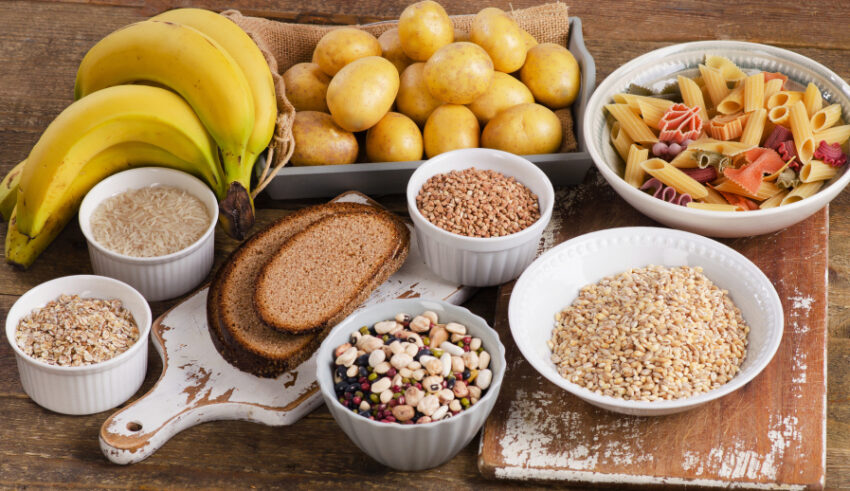Carbohydrates are one of the main sources of energy. They are essential for physical activity, cognitive function and overall metabolism. However, not all carbohydrates are created equal. The quality, processing and glycemic index of the carbohydrates you consume can influence health, performance and weight management.
Carbohydrate Classification
Carbohydrates can be classified into simple and complexes depending on their structure and the speed with which they are digested and absorbed by the body.
Complex carbohydrates: They are the best option because they provide sustained-release energy, contain fiber, and provide essential nutrients. They are found in foods such as vegetables, legumes, whole grains, and tubers.
Simple carbohydrates: They are absorbed quickly, which can cause spikes in blood glucose if consumed in excess. They are found in foods such as breads, pastas, fruits, soft drinks and sweets.
Refined and ultra-processed carbohydrates: Let's start with what you should avoid
Refined carbohydrates have been stripped of their fiber and nutrients, making them a quick but inefficient source of energy. Excessive consumption can cause sharp increases in glucose levels and contribute to metabolic problems such as insulin resistance and obesity.
The most problematic foods include white bread, white rice, refined pasta, cookies, soft drinks and sugary cereals. These products often contain highly processed flours and added sugars that affect metabolic health.
Vegetables and greens
Vegetables are one of the healthiest sources of carbohydrates. They provide fiber, vitamins, minerals and antioxidants without causing increases in glucose levels, so they can be consumed in large quantities. In addition, they promote digestion and satiety, making them an excellent option for any type of diet.
How to choose vegetables at the market?
- Choose fresh and seasonal vegetables, as they have better flavor and higher nutritional content.
- Opt for organic versions to avoid pesticides.
- Avoid canned goods with added sugars or artificial preservatives.
Cereals and whole grains
Cereals and whole grains are an excellent source of complex carbohydrates. They provide fiber, protein and essential minerals such as magnesium and iron.
Among the best options are the Oats, quinoa, brown rice, buckwheat and barley, as they provide long-lasting energy and prevent blood glucose spikes.
Brown rice and quinoa are ideal as accompaniments to meals, while oatmeal is an excellent choice for breakfast due to its soluble fiber content, which helps regulate digestion and blood sugar levels.
How to choose cereals and grains in the market?
- Opt for whole grain versions instead of refined ones, as they retain more fiber and nutrients.
- If you choose packaged products, check that the label indicates 100% integral as the first ingredient.
Tubers and roots
Tubers and roots such as sweet potato, cassava, carrot, beet and potato They are carbohydrates rich in fiber, antioxidants and essential micronutrients. They are a natural source of energy and moderate absorption, making them an excellent option for those seeking physical performance and muscle recovery.
Sweet potato is especially beneficial due to its high vitamin A content and lower impact on glucose levels compared to white potatoes.
How to choose tubers at the market?
- Choose tubers that are fresh and without visible damage.
- Avoid pre-cooked, frozen or additive-laden versions.
Legumes
Legumes such as chickpeas, lentils, beans and peas They are a source of complex carbohydrates with a high content of vegetable protein and fiber, which promotes satiety and favors weight control.
To improve digestion and nutrient absorption, it is advisable to soak them before cooking.
Why is soaking legumes important?
- Reduce antinutrients such as phytates and lectins, which can interfere with the absorption of minerals such as iron and zinc.
- Improves digestibility, reducing gas production and the feeling of bloating.
- Speeds up cooking, allowing the legumes to become more tender in less time.
For best results, soak legumes for 12 to 24 hours in filtered water with a pinch of baking soda or a few drops of lemon. Then rinse thoroughly before cooking.
How to choose legumes in the market?
- Choose dried and natural legumes, since canned ones may contain sodium and preservatives.
- If you choose canned legumes, rinse them well to reduce excess salt.
Fruit
Fruits contain natural sugars, but their impact on blood glucose is moderate due to their fiber and antioxidant content. They are an excellent option for obtaining quality carbohydrates, as long as they are consumed in their whole form and not in processed juices.
Top options include berries (strawberries, blueberries, raspberries), apples, pears, oranges and kiwis, since they have a high fiber content and a lower glycemic index.
Tropical fruits like mango and pineapple are higher in sugar, so it's best to consume them in moderation, especially on diets focused on fat loss or glucose control.
How to choose fruits at the market?
- Choose seasonal and local fruits, as they tend to be fresher and more nutritious.
- Opt for organic versions to avoid pesticides and ensure the absence of genetic modifications (GMO-free).
- Avoid canned or syrupy versions, which contain added sugars.
- If you buy dried fruit, make sure it does not have added sugars or preservatives.
Conclusion: The key is quality and balance
Carbohydrates are an essential source of energy, but their impact on health depends on the quality and type you choose. Prioritizing vegetables, root vegetables, whole grains, legumes, and whole fruits is key to getting the benefits without negatively affecting blood glucose levels.
It is important to avoid refined and ultra-processed carbohydrates, which can cause inflammation and metabolic imbalances. Instead, opt for natural, fiber-rich sources that provide sustained-release energy.
By following these guidelines, carbohydrates can become an ally for physical performance, metabolic health and general well-being.
